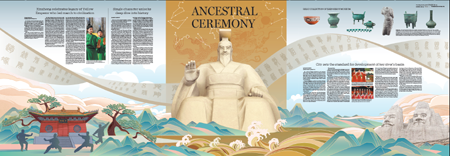There is no other city like Zhengzhou of Henan province in China where just a single character in the local dialect reveals its culture and history.
Zhong is the most frequently used character in the dialect of Henan province, and when people say it, it usually means agreement or approval. However, the character can also be used to describe moderation or other implications related to historical culture and geographical location.
As the capital of the Central China province, Zhengzhou has had an inseparable relationship with the character zhong since ancient times. Civilization featuring zhong is believed to have taken shape in the Songshan Mountain area that boasts stunning natural and cultural heritage in Dengfeng, a county-level city of Zhengzhou, where China's first central dynasty Xia Dynasty (c. 21st century-16th century BC) was founded.
Historians have deduced from the legacy of the ancient observatory at the foot of Songshan Mountain that people confirmed Dengfeng should be the center of heaven and earth by observing celestial phenomena and local terrain — giving rise to its reputation as the birthplace of Chinese civilization. This cosmology was later agreed upon and promoted by ancient rulers of different dynasties as they believed only by being at the center of heaven and earth could they rule the world impartially and achieve the goal of harmonious governance.
"The 'unity in diversity' of Chinese civilization that we read about today mainly originated in the Central Plains region. With the capitals of the Xia, Shang and Zhou dynasties built around Songshan Mountain, the cosmology of the Center of Heaven and Earth held by the people in Zhengzhou gained recognition from people in other regions.
"The area surrounding Songshan Mountain began to be known as the Central Plains, with the core area around Zhengzhou being acknowledged as the central location, evolving into the character for zhong in written Chinese," said Yan Tiecheng, a cultural scholar.
In August 2010, the Dengfeng Center of Heaven and Earth historical building complex at Songshan Mountain was listed as a world cultural heritage site by UNESCO, validating the ancient Chinese concept that is widely recognized around the world. The historical monuments include eight clusters of buildings and sites, including three Han Que gates, Zhongyue Temple, the Zhougong Sundial Platform, and the Dengfeng Observatory.
Constructed over the course of nine dynasties, these buildings are reflections of different ways of perceiving the center of heaven and earth and the power of the mountain as a center for religious devotion. Other sites registered include the Songyang Academy (484 AD), the 1,500-year-old Pagoda of Songyue Temple and Pagoda Forest at the Shaolin Temple.
Besides recording Zhengzhou's profound history, the Songshan Mountain site has witnessed the city's culture, including kung fu, flourishing and advancing Confucianism, Buddhism and Taoism. Revered as a key national Buddhist monastery, Shaolin Temple at the southern foot of Songshan Mountain is the birthplace of both the famous martial arts of Shaolin, or Shaolin kung fu, and the Zen culture of Chinese Buddhism.
As a symbol of traditional martial arts of China, Shaolin kung fu is the largest school among its peers, with more than 700 different skills. For over a millennium, Shaolin kung fu has evolved into a comprehensive system, blending martial arts and Zen theory, setting it apart from schools that solely focus on combat techniques.
Meanwhile, the Zen culture stemming from the local dissemination of Buddhism, has profoundly influenced the cultural development of several East Asian countries while becoming a globally influential cultural phenomenon. By leveraging the two iconic cultural elements of kung fu and Zen culture, "Kungfu Zhengzhou" has established its brand in showcasing Zhengzhou's international status in the world.

